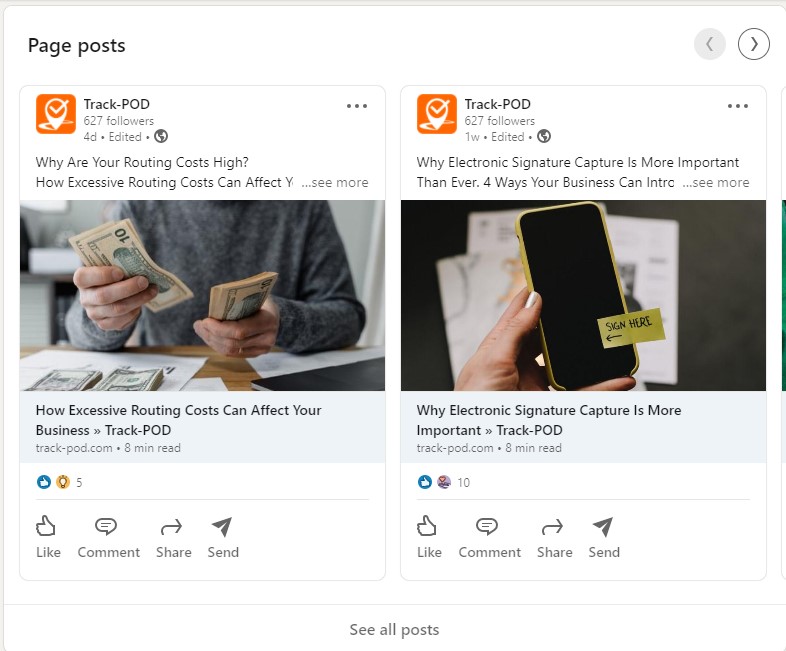How to Use Inbound Links to Improve Your Business’s Search Ranking

With dozens of factors determining your website’s search ranking, how do you choose where to begin?
Thankfully, Google has given us a few hints. We’ve used those hints to hone in on one of the single most important elements for your SEO strategy: inbound links.
This powerful SEO strategy is often overlooked, so it’s the perfect way to gain a competitive advantage.
In this article, we’ll cover what inbound links are, how they help your search ranking, and seven key ways to build inbound links for your website.
What Are Inbound Links?
Inbound links point from another website back to your own. You might also see them called backlinks or incoming links.
All links that direct users to your website are inbound links, while any links on your website that direct readers to external sites are outbound links.
How Do Inbound Links Affect Your Google Ranking?
Inbound links are a way for other websites to demonstrate that they consider your business trustworthy and authoritative in your niche.
A common analogy is that inbound links are like votes. The more votes a website has, the higher its ranking is likely to be.
More links won’t always mean a higher ranking, however. Low-authority or spammy links will do virtually nothing for your website. In extreme cases, they could even hurt your business.
That said, more than 66% of web pages have no inbound links at all, according to a study by Ahrefs. That means there’s tons of opportunity to outpace your competitors by building high-quality and effective inbound links.
Effective inbound links build on stellar SEO content, a logical site architecture, and a good user experience, among other factors. Let’s take a closer look at some of the best ways to build strong backlinks.
7 Best Practices to Build Inbound Links
You can approach inbound link building through many different strategies, but there are a few tried-and-true tactics that are a good place to start. Here are some important best practices for building inbound links.
Targeting Keywords
An effective inbound link connects a web page to its primary keywords by using those keywords in the anchor text.
The anchor text, or the words used to indicate a link, will act as a preview for what the reader or search engine will find when they follow that link.
The more specific your anchor text, the more powerful your inbound link will be on your search engine rankings.
Let’s look at an example from Swagbucks, a popular online coupon site. Its Old Navy coupon page, shown below, has thousands of inbound links, but most of them aren’t targeting any useful keywords.
According to a SEMrush report on the Old Navy page, most of the inbound links use one of these anchor texts:
- Get coupon
- Get link coupon
- Get deal now
- The full page URL
While these are technically relevant to the page, they are also relevant to many pages on Swagbucks.
Some better, more specific options are:
- Old Navy coupons
- Save money at Old Navy
- Old Navy deals
See the difference? The second set of keywords is much more specific about what someone might find when they click on the link. That makes it more useful and more powerful.
Guest Posting & Building Authority
As one of the most popular link building tactics, guest posting can pack a powerful punch — when it’s done correctly.
In a guest posting strategy, a representative from your business writes original content in your niche to be published on industry websites. Most of the time, this representative should be a public-facing leader of your business, such as the CEO.
A guest post is more than just a way to get a link pointing to your website. It also allows you to establish your business as an authority in the industry.
That’s what Drew Cheneler, the founder of Simple Money Lyfe, did. Through a series of guest posts on sites like ReadWrite and Business2Community, Cheneler built inbound links to his website and positioned himself as an authority in this space.
Guest posting works best as an ongoing strategy. Finding guest post opportunities, writing SEO-optimized content, and submitting and placing each article is a time- and resource-intensive endeavor. You’ll get a better ROI if you commit to this strategy for the long term.
Asking Suppliers and Partners to Link Back to Your Site
An easy way to get some inbound links for your site is to ask your suppliers, vendors, and partners to link back to you.
Many businesses — perhaps even yours — list their clients or partners on their website, so this is usually a simple ask.
Be sure to provide the partner organizations with any information they might need to create the inbound link. The easier you make it for them, the more likely you are to see the inbound link appear on their site.
Creating Shareable Content
The best practices for inbound links that we’ve covered so far rely on you actively pursuing inbound links. But when you create high-quality, shareable content, you can gain those links naturally.
When thinking of good content for link building, think about what other sites would want or need to link back to. Statistics, infographics, and interactive content are all assets that other people remember and tend to link back to without any additional effort on your part.
For instance, this compilation of podcast stats from Buzzsprout is a great example of high-quality content for link building.
The page is clean and visually appealing, with the information presented in a clear and easy-to-understand format. And with so many statistics listed, there are plenty of opportunities for another site to link to this asset.
If you don’t have the resources to build a content asset as Buzzsprout did, there’s still plenty you can do to make your product pages stand out.
For instance, PandaDoc, a document signing software, includes videos on their product pages to engage visitors and encourage shares.
74% of marketers say video has a stronger ROI than plain images, so this is an effective way to take your landing pages to the next level. You’ll gain inbound links and perhaps even a few more customers.
Getting Social
Posting an article on Twitter isn’t the same as a regular inbound link, but social media can still have a big impact on your link building strategy.
In many ways, social media acts as a support for the other inbound linking best practices we’ve already discussed. It offers exposure for your brand and opportunities to build relationships with other sites and businesses.
Through this exposure and relationship building, other people see your content and may decide to link to it. You may also find opportunities for guest posting or other partnerships that benefit your inbound link profile.
B2B businesses, in particular, can leverage this approach through LinkedIn, as route planning software provider Track-POD does.
When incorporating social media into your link building strategy, it’s important to follow social media best practices for posting and engaging with your audience. That way, you’ll make the most of your social media presence, and your business as a whole will benefit.
Submitting Press Releases
Press releases announce company news, such as a product release, upcoming event, or high-profile hire. These short statements are then distributed to journalists, who can use the information to write a news story about your announcement.
Usually, the press release itself won’t provide you with an inbound link. That’s because press release distribution sites often use nofollow tags on any included links. This signals to Google that a link shouldn’t contribute to SEO.
But creating press releases can garner news coverage for your business, which may yield a link on a high-profile news site — an effective place to get more authority and more traffic.
Getting Listed in Directories
Online directories list businesses in a certain niche or industry, usually providing a link to the website and other contact information. Sites like Yelp or Angie’s List are commonly known directories.
Today, directories are most useful for local SEO. By adding or claiming your business on popular directories, you’ll let Google know crucial information. Then, searchers in your city or region will be able to find you based on proximity.
Build Inbound Links to Boost Your SEO
Inbound links are a powerful and effective way to improve your search engine rankings.
To get the most out of a link-building strategy, you need to put in the time and effort. Obtaining inbound links can be an intensive process, but with the help of our best practices, you’ll be well on your way to improving your search engine rankings.







